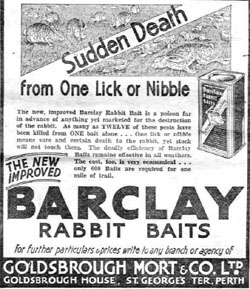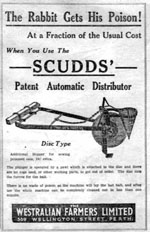|
 With
the rabbits in plague proportions, local councils employed 'Rabbiters'
to drive a horse-drawn 'poison cart', laying baits for the rabbits by
the side of the roads and near the rivers. With
the rabbits in plague proportions, local councils employed 'Rabbiters'
to drive a horse-drawn 'poison cart', laying baits for the rabbits by
the side of the roads and near the rivers.
Charlie Ellery recalls: "The poison was a phosphourus
- we used to mix it up with bran and pollard and then you'd put it in
this big container on the poison cart, push the lid down to put pressure
on it. Then you'd drive along and it would squeeze the stuff out of a
little tiny hole down the bottom. There was a crank which would cut off
bits about 3cm long."
 Farmers
would poison rabbits too, using cyanide or strychnine. The usual method
was to free feed the rabbits for two or three nights, using clean oats
or wheat laid in a shallow trail which was cut using a single-furrowed
plough. The rabbits would become accustomed to being fed, and then after
a few nights, the poisoned grain would be layed out. As Bob O'Neill Holmes
explains: "The trail was not all poisoned. You'd put fresh oats,
then poisoned, then fresh oats. So you sort of kidded them into eating
the trail anyway. They were a bit suspicious." Farmers
would poison rabbits too, using cyanide or strychnine. The usual method
was to free feed the rabbits for two or three nights, using clean oats
or wheat laid in a shallow trail which was cut using a single-furrowed
plough. The rabbits would become accustomed to being fed, and then after
a few nights, the poisoned grain would be layed out. As Bob O'Neill Holmes
explains: "The trail was not all poisoned. You'd put fresh oats,
then poisoned, then fresh oats. So you sort of kidded them into eating
the trail anyway. They were a bit suspicious."
 Poisons
like strychnine were also a danger to stock, native animals and pets.
Farmers would have to ensure that any left-over baits did not remain on
the ground, and even the bodies of the poisoned rabbits would be collected. Poisons
like strychnine were also a danger to stock, native animals and pets.
Farmers would have to ensure that any left-over baits did not remain on
the ground, and even the bodies of the poisoned rabbits would be collected.
Farmers also poisoned watering holes where rabbits congregated.
Charlie Ellery recalls: "We did one lot of cyanide, on a farm out
from Meckering. There was a soak on it and the rabbits used to drink out
of it. We poisoned that one night - went back the next morning and there
were hundreds of rabbits dead everywhere. The poison doesn't last in the
water that long - leave it for a little while and the sheep can drink
out of it again."
|

 With
the rabbits in plague proportions, local councils employed 'Rabbiters'
to drive a horse-drawn 'poison cart', laying baits for the rabbits by
the side of the roads and near the rivers.
With
the rabbits in plague proportions, local councils employed 'Rabbiters'
to drive a horse-drawn 'poison cart', laying baits for the rabbits by
the side of the roads and near the rivers. Farmers
would poison rabbits too, using cyanide or strychnine. The usual method
was to free feed the rabbits for two or three nights, using clean oats
or wheat laid in a shallow trail which was cut using a single-furrowed
plough. The rabbits would become accustomed to being fed, and then after
a few nights, the poisoned grain would be layed out. As Bob O'Neill Holmes
explains: "The trail was not all poisoned. You'd put fresh oats,
then poisoned, then fresh oats. So you sort of kidded them into eating
the trail anyway. They were a bit suspicious."
Farmers
would poison rabbits too, using cyanide or strychnine. The usual method
was to free feed the rabbits for two or three nights, using clean oats
or wheat laid in a shallow trail which was cut using a single-furrowed
plough. The rabbits would become accustomed to being fed, and then after
a few nights, the poisoned grain would be layed out. As Bob O'Neill Holmes
explains: "The trail was not all poisoned. You'd put fresh oats,
then poisoned, then fresh oats. So you sort of kidded them into eating
the trail anyway. They were a bit suspicious." Poisons
like strychnine were also a danger to stock, native animals and pets.
Farmers would have to ensure that any left-over baits did not remain on
the ground, and even the bodies of the poisoned rabbits would be collected.
Poisons
like strychnine were also a danger to stock, native animals and pets.
Farmers would have to ensure that any left-over baits did not remain on
the ground, and even the bodies of the poisoned rabbits would be collected.